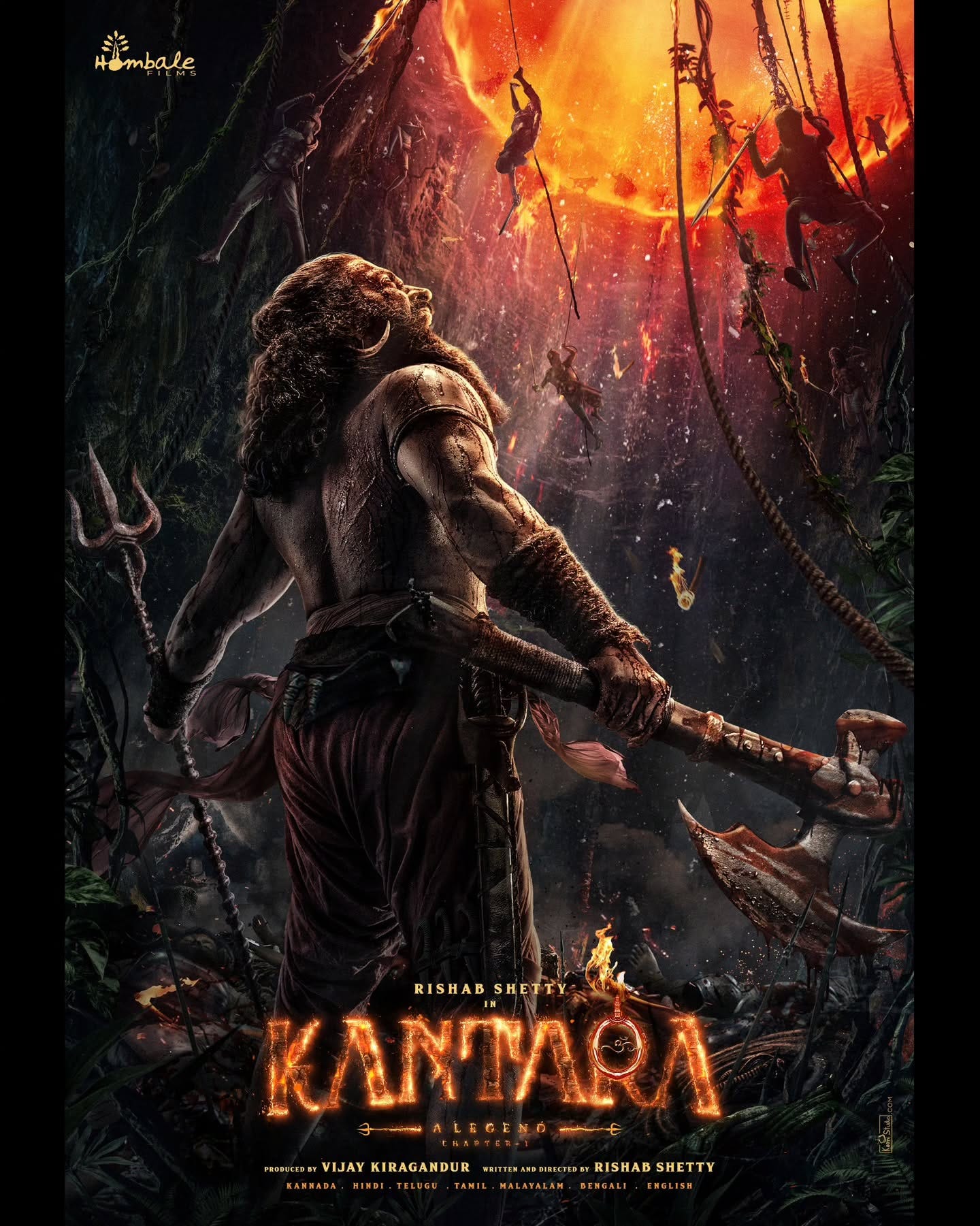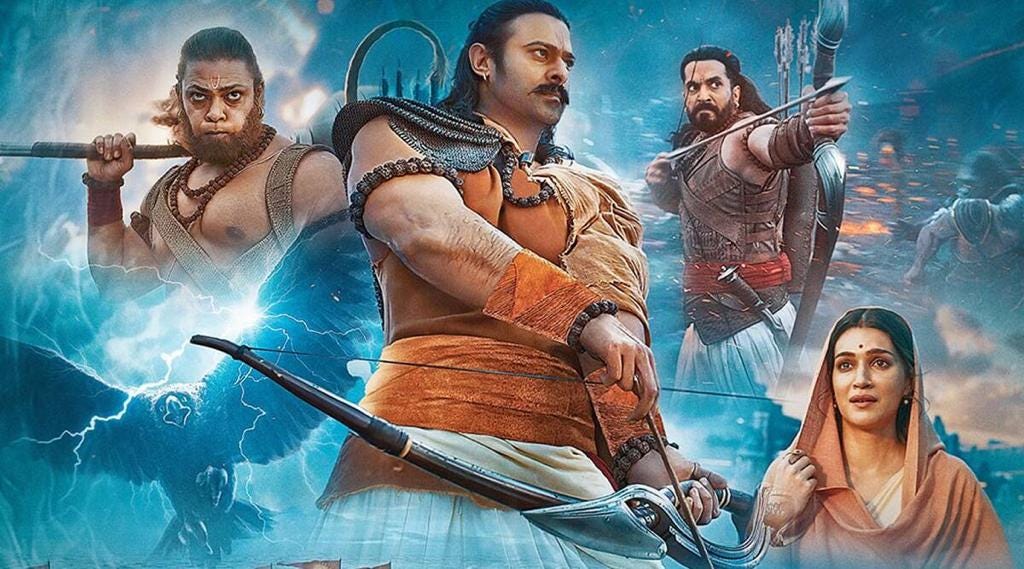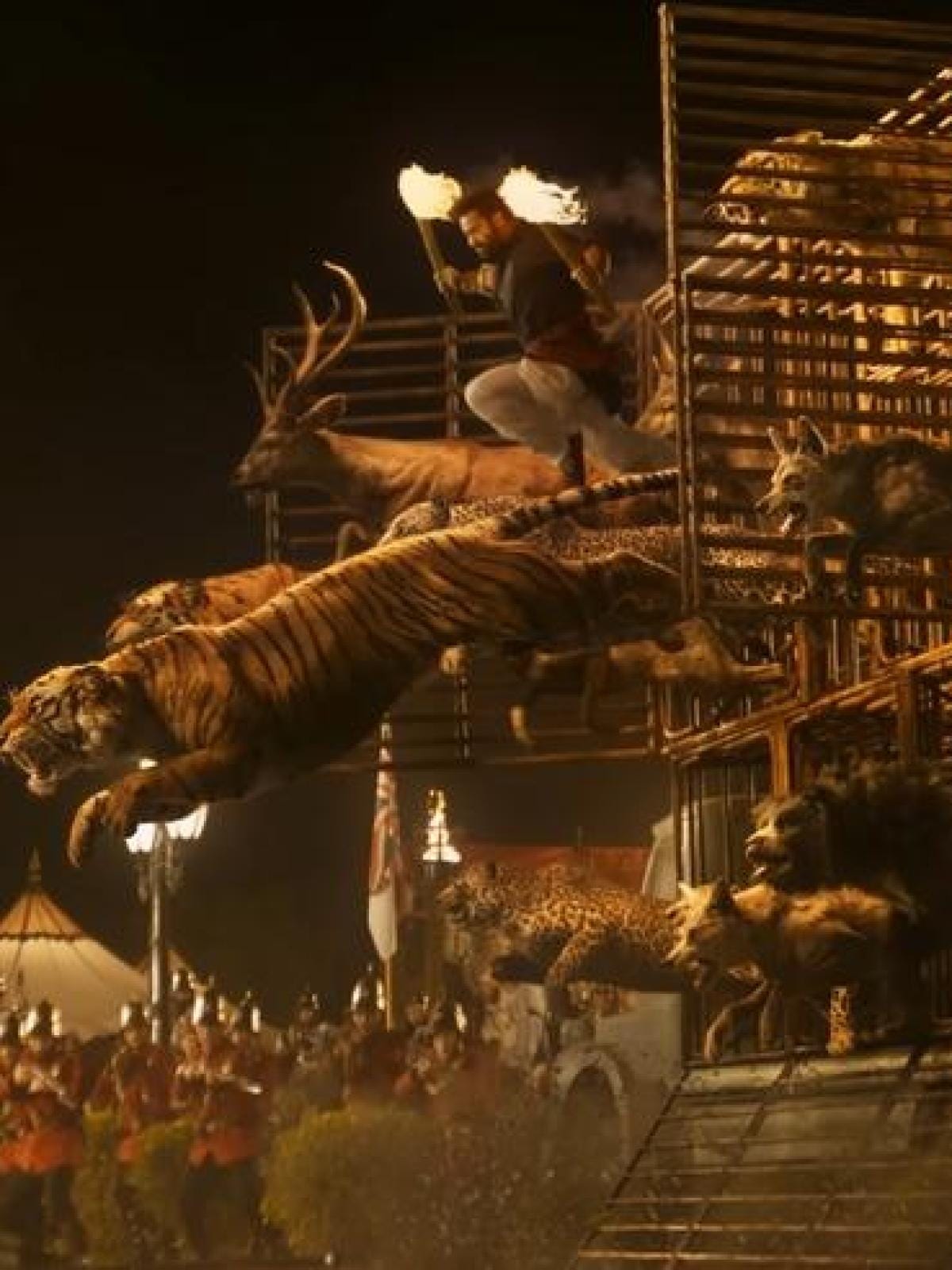I watched the much-awaited, much-hyped Kantara Chapter 1, the prequel to the sleeper hit Kantara. This one is historical epic fantasy, so I had to watch it. I loved it! Lives up to the hype! But it’s not as tight as Kantara, and has many plot holes. Let’s discuss it!
The Movie
Kantara was an unexpected kind of movie with a plot no one would have predicted. The son of a disappeared bhootakola performer does every possible thing that makes him unfit for the role — until changing circumstances in his village make him heed the call of the spirits and fulfill his role in the cosmos.
I gotta say, Kantara Chapter 1 is an awkward name for the second movie in a series, even if it’s a prequel. Maybe the first movie can be retroactively subtitled Kantara Chapter 4 - A New Hope. This prequel takes us back 1500+ years.
I don’t know where I heard that it shows us the origins of bhootakola, but the movie does no such thing - the characters are already performing the kola and channeling the ancient spirits to guide their decision-making. So, if anything, it could be seen as one of the many legends in that universe.
It’s a pretty long movie, but two things keep you riveted - it’s a huge visual treat, and there’s never a dull moment.
Like, look at these frames.
This is on a budget of ₹125 Crore. Compare with Adipurush which was on a budget of ₹600-800 Crore
One possibility is that the Kantara team just spent much less on star actors and managed to actually splurge on good-quality VFX. There are so many scenes with wild animals, and it didn’t even register with me that they were VFX at first. Contrast with the wild animals in RRR, which feel much less natural.
Is it Gen-AI that makes this smoother? I’d really like to know.
So the plot is pretty straightforward, and events happen fast.
The people of the forest, led by Berme (Rishab Shetty), see the nearby royals (Gulshan Deviah as a wayward prince, Rukmini Vasant as the tough and smart princess, and Jayaram as their father) come to their land with ill intent. They decide they can’t just sit by, and they go to the capital city.
They quickly adapt to trading forest produce for weaponry, but see that the port is used to trade slaves. They capture the port in protest. This triggers long-standing intrigues and machinations, both by people and by the Gods, which form the action-packed second half.
The first half has the camera moving from highlight to highlight - a quick backstory, an intro fight scene, glimpses of an ancient-era trading port, our hero creating a ruckus, having a meet-cute with the leading lady, Portuguese and Arab traders, goofy comedy scenes. There are faces from the first movie playing the long-ago versions of their characters. It’s riveting. I was glued to my seat, enjoying it all while wondering when the plot would begin.
It does in the second half, where we meet the rival tribe that practices dark magic, their influence on the royals, and there becomes a pitched battle between the Gods and forces of evil that seek to control them.
In historical/fantasy movies, there’s always a long battle/struggle scene that lasts about an hour, and where I lose interest. Kantara Chapter 1 keeps it tight.
I found every aspect of it quite immersive - the acting, the looks, the dialogue, and heck, even the comedy. Some of the comedy scenes remind me of scenes from Vadivelu movies, and I’ve seen both Gulshan Deviah and Rishab Shetty reference his comedy, so I assume it’s all intentional.
My husband watched it with me. He hadn’t watched the first movie, and he had no clue about Deivaradhane or Bhoothakola. So some of it felt like an overuse of deus ex machina for him. On the other hand, I think it fits into the plot of how the Gods get triggered enough to come to earth and protect us from adharma.
When I compare Kantara Chapter 1 to the first movie, it feels much less tight. The first movie was a small, focused story, tightly plotted, and it had a killer trailer. The Chapter 1 trailer isn’t as amazing as it could have been, and the posters are much less intriguing than they could have been.
Plus, there are so many more plot holes. The scene with Gulshan Deviah at war in the forest feels strangely off-pace. The rival tribe subplot has its own holes and could have been fleshed out so much better. And, history — slaves and the Portuguese in the era of the Kadambas? Like, even if you stretch the timeline by saying the royals in the movie are chieftains under the last of the Kadambas, who themselves were vassals to other kingdoms, it still won’t be dated after the Portuguese came to India.
But there’s a historical fantasy with Portuguese and Kannada swearwords coexisting, and that’s enough for me.
The Plotting
Kantara was a straight-up hero’s journey, where he gets a call to action, refuses it, and then undergoes personal transformations that make him ready for the call to action. It is a canvas full of interesting characters, but the focus is always on Shiva, the main character.
Kantara Chapter 1, OTOH, has a larger cast of characters, who aren’t just viewed through the lens of the main character, and more time is spent on their point of view as well. And Berme is the Legendary Hero from Indian epics, who was essentially born perfect, and doesn’t have to go through much evolution. Instead, the plot is about him just living through extraordinary times and solving extraordinary problems.
This is something I’ve wrestled with in my novel - most Western frameworks of storytelling necessitate conflict and character growth, and I have tried all kinds of configurations to show character growth on the emotional journey. In a lot of Indian biopics, they do this by inserting a villainous official or referee before the main character has their climactic medal-winning game. People rightly find this hilarious.
There needs to be a better way to do this. Maybe Berme is a Mary Sue character, but Kantara Chapter 1 is still riveting. How does it accomplish this?
It elevates the stakes.
So Berme may be perfect, but he’s perfect as a tribesman, and still subject to whatever the kings and queens of the land decide. Normally, a king versus a tribe wouldn’t even be a plot because the stakes are so uneven, but in this case, the stakes are evened out a bit by making the tribe have the blessings of the Gods and (hence) a perfect leader who can strategize and fight back.
So if we make an Indian sports biopic about Olympic medal winners, then you can make the main character effortlessly perfect, but then they are representing India when it’s an underdog country in sports.
The History
This movie mixes up a lot of history, and all of it can be fixed by just removing the Portuguese from the movie.
I understand wanting to set a movie about Hindu rites and rituals in an era that doesn’t have Islam or Christianity to contend with - it prevents distractions, both in plot as well as reception. So, setting it in the era of the peak Kadamba empire - 350-500 CE makes perfect sense. And I think they mention the capital as Banavasi, so it’s definitely not later-era Kadambas who were vassals of other kings.
The Arab characters in the movie are, I suppose, historically accurate — we have traded with Mesopotamia for thousands of years.
But adding a Portuguese character throws the whole thing off.
In the 300-500 CE era, Portugal was part of the Roman Empire. The Roman empire was declining from 400-700 CE, and Germanic groups were invading Portugal, and some of them established kingdoms. It would take the Crusades to cut off trade between Europe and India, all the way until 1498 when Vasco da Gama came to India.
Just changing the Portuguese traders to Roman traders would make great sense, but I assume they wanted to do some fan service/acknowledgement of the Arab and Portuguese influence in coastal Karnataka/Goa.
Besides, it’s fun to hear ‘your mother’s a ho’ in Kannada as well as Portuguese, so all that is forgiven.
The slave trading aspect of the whole thing rubbed me the wrong way, though. Romans and Arabs had slavery, but I’m not sure it would be accurate to depict it the same as chattel slavery. In any case, many foreign travelers to India commented on the lack of slavery in the country, so making the local king a slave trader feels ahistorical.
Especially since slavery and the slave trade in India were an Islamic conquest thing, where people captured in war were sold in slave markets all the way in the Middle East. It was also a Portuguese thing - the Portuguese captured slaves from every port they traded with and transported them all around. There is a wonderful book titled Asian Slaves in Colonial Mexico that talks of how men and women from Malabar and Mangalore were captured and traded all the way to Mexico via the Philippines.
If slavery was shown to be the case under the influence of traders who came looking for slaves to trade, that would have fit in better.
I suppose this was painted this way because there needed to be something unassailably, unquestionably villainous about the villains. It’s one of the plot contrivances in this movie, kind of like the dark magic tribe… like, are they supposed to be all-out evil? How did they get that way? Why do they exist then? It’s sort of like Slytherin in Harry Potter - everyone in it is just evil, for no reason other than plot contrivance.
Things I want Rishab Shetty to stop doing
I’m sure he is more aware of this than me, but… maybe let’s leave the daivas be. When the bhoothakola becomes a plot device, we in the audience start having expectations of it, and … yeah, that’s probably not good.
We’re already seeing people wearing bhoothakola costumes and such, and imitating the characters possessed by the deities… which is not advisable.
Maybe we can move on to other themes in the same world.The first half of all the movies made by the Shetty gang (Rishab, Raj, and Rakshith) have men being degenerate AF. Fun, cheerful degenerates, but degenerates nonetheless. Everyone was talking about how Su from So was such a sweet little comedy, but my aunt tried watching it and walked out annoyed. When I watched it, I understood why — men drinking too much, awkwardly hitting on women, and otherwise being degenerates. It was the case in Kantara, and it turned off a lot of people, but it was explained as the main character being an anti-hero sort. Chapter 1 has a similar vibe, and I found it annoying at times. But who cares what my aunt and I think?
My Takeaways from Chapter 1 (for Better Historical Fiction)
You need a funny sidekick in the first half
When you’re creating a new world, you need an audience-surrogate character, so the reader can explore the world and be entertained while learning all about it. It also serves to teach your main character about parts of the world he or she doesn’t know.
In Chapter 1, it’s Chenna, a lazy, philandering soldier. In Kalki’s Ponniyin Selvan, it’s Azhwarkadiyan Nambi.
If you know only a little, that’s when you can make comedy - if you know less, you’re just clueless, and if you know more, things get too serious. So you need a character with some knowledge gaps, but not too much.
Plus, comedy draws people to new, unknown, and possibly uncomfortable situations. I’d be reluctant to read something serious about kings and queens in the Chola empire, but then you want to see Azhwarkadiyan bumbling through things, sneakily watching, and other shenanigans.
I tried doing this in the first draft of my novel, but it was getting too epic and I had to give up. There is still comedy, but not as much as I hoped to have had.
Your character needn’t undergo emotional growth through conflict
We discussed this earlier in this post. There can be a Mary Sue character, but then you have to challenge them accordingly, by giving them adversaries that will take work to counter.
Don’t let the worldbuilding be dull.
In Chapter 1, the worldbuilding is 1) shown through quick narrations by a narrator, so it’s only highlights, not full scenes. 2) shown glimpses of through action scenes 3) through exciting and memorable characters, like Peppe.
It feels important to do this, but I find it hard to do well. Some of the problems with the first quarter of my book is there’s worldbuilding that I try to do through action, but then, it just looks like forced infodumping through boring action.
Getting historical facts wrong is fine if you’re directionally correct.
The sequence of events exactly as it occurred is often kinda boring unless you’re talking about when things went very right or very wrong in an unexpected way. Not all stories are only about these things. You need to move things around for plot reasons.
But specifics don’t matter as much as being directionally correct on history. Most people only really absorb the vibes of a story, not so much the specific facts unless they themselves are riveting.
Have a serious core that you completely identify with.
There needs to be something solid that you, the writer, believe in completely. The whole story can be built around that feeling or event that you want to explore. But it has to be solid because that’s what intrigues people. The background score and acting and costumes can be top-notch, but no one will care if the core isn’t something that communicates your strong belief.
Kantara did this much better than Chapter 1, which is why it’s a much more riveting movie on a personal level. But the cast and crew still believe strongly in the core, so Chapter 1 can be an epic movie with an expansive world and still feel personal, even if not to the same extent as Kantara.
Ultimately, that’s what it’s all about — what’s the vision you have for your characters. In interviews, Rishab Shetty says Kantara was all about the final image where everyone holds hands. Working towards that plot-wise and emotionally is what made the movie what it is.
I guess that’s something to think about as a writer.




